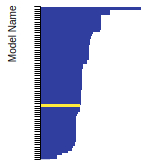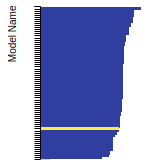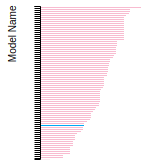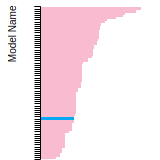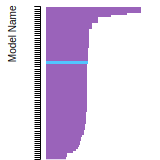Sim_LAMMPS_BOP_ZhouWardFoster_2016_AlCu__SM_566399258279_001
| Title
A single sentence description.
|
LAMMPS BOP potential for the Al-Cu system developed by Zhou, Ward, and Foster (2016) v001 |
|---|---|
| Description |
Al-rich Al1-xCux alloys are important structural materials in the aerospace industry due to their high strength to density ratio. They are also emerging materials for hydrogen containing structures due to their potentially high resistance to hydrogen embrittlement. To enable accurate simulations of the mechanical behavior of Al1-xCux alloys that can guide material improvement, we have developed a high-fidelity analytical bond-order potential (BOP) for the Al-Cu system (the code is publically available in molecular dynamics package LAMMPS). The formalism of the potential is derived from quantum mechanical theories, and the parameters are optimized in an iteration fashion. The iterations begin by fitting properties of a variety of elemental and compound configurations (with coordination varying from 1 to 12) including small clusters, bulk lattices, defects, and surfaces. Following the fitting process, crystalline growth of important equilibrium phases is checked through molecular dynamics simulations of vapor deposition. It is demonstrated that this Al-Cu bond-order potential has unique advantages relative to existing literature potentials in reproducing structural and property tends from experiments and quantum-mechanical calculations, and providing good descriptions of melting temperature, defect characteristics, and surface energies. Most importantly, this BOP is the only potential currently available capable of capturing the Al-rich end of the Al-Cu phase diagram. This capability is rigorously verified by the potential's ability to capture the crystalline growth of the ground-state structures for elemental Al and Cu, as well as, the theta and theta' phases of the Al2Cu compound in vapor deposition simulations. HISTORY: Changes in version 001: * Parameter file updated to latest version distributed with LAMMPS in order to correct for missing rows |
| Species
The supported atomic species.
| Al, Cu |
| Disclaimer
A statement of applicability provided by the contributor, informing users of the intended use of this KIM Item.
|
None |
| Content Origin | LAMMPS package 30-Jul-2021 |
| Contributor |
Ronald E. Miller |
| Maintainer |
Ronald E. Miller |
| Developer |
Xiaowang Zhou Donald K. Ward Michael E. Foster |
| Published on KIM | 2021 |
| How to Cite |
This Simulator Model originally published in [1] is archived in OpenKIM [2-4]. [1] Zhou XW, Ward DK, Foster ME. An analytical bond-order potential for the aluminum copper binary system. Journal of Alloys and Compounds [Internet]. 2016Sep;680:752–67. Available from: https://doi.org/10.1016/j.jallcom.2016.04.055 doi:10.1016/j.jallcom.2016.04.055 — (Primary Source) A primary source is a reference directly related to the item documenting its development, as opposed to other sources that are provided as background information. [2] Zhou X, Ward DK, Foster ME. LAMMPS BOP potential for the Al-Cu system developed by Zhou, Ward, and Foster (2016) v001. OpenKIM; 2021. doi:10.25950/3758c8eb [3] Tadmor EB, Elliott RS, Sethna JP, Miller RE, Becker CA. The potential of atomistic simulations and the Knowledgebase of Interatomic Models. JOM. 2011;63(7):17. doi:10.1007/s11837-011-0102-6 [4] Elliott RS, Tadmor EB. Knowledgebase of Interatomic Models (KIM) Application Programming Interface (API). OpenKIM; 2011. doi:10.25950/ff8f563a Click here to download the above citation in BibTeX format. |
| Citations
This panel presents information regarding the papers that have cited the interatomic potential (IP) whose page you are on. The OpenKIM machine learning based Deep Citation framework is used to determine whether the citing article actually used the IP in computations (denoted by "USED") or only provides it as a background citation (denoted by "NOT USED"). For more details on Deep Citation and how to work with this panel, click the documentation link at the top of the panel. The word cloud to the right is generated from the abstracts of IP principle source(s) (given below in "How to Cite") and the citing articles that were determined to have used the IP in order to provide users with a quick sense of the types of physical phenomena to which this IP is applied. The bar chart shows the number of articles that cited the IP per year. Each bar is divided into green (articles that USED the IP) and blue (articles that did NOT USE the IP). Users are encouraged to correct Deep Citation errors in determination by clicking the speech icon next to a citing article and providing updated information. This will be integrated into the next Deep Citation learning cycle, which occurs on a regular basis. OpenKIM acknowledges the support of the Allen Institute for AI through the Semantic Scholar project for providing citation information and full text of articles when available, which are used to train the Deep Citation ML algorithm. |
This panel provides information on past usage of this interatomic potential (IP) powered by the OpenKIM Deep Citation framework. The word cloud indicates typical applications of the potential. The bar chart shows citations per year of this IP (bars are divided into articles that used the IP (green) and those that did not (blue)). The complete list of articles that cited this IP is provided below along with the Deep Citation determination on usage. See the Deep Citation documentation for more information. 
Help us to determine which of the papers that cite this potential actually used it to perform calculations. If you know, click the .
USED (definite) X. W. Zhou and S. Foiles, “Uncertainty Quantification and Reduction of Molecular Dynamics Models.” 2017. link Times cited: 9 Abstract: Molecular dynamics (MD) is an important method underlying th… read more USED (high confidence) M. Abdulrehman, M. Hussein, and I. Marhoon, “Temperature-dependent mechanical properties of Al/Cu nanocomposites under tensile loading via molecular dynamics method,” Curved and Layered Structures. 2022. link Times cited: 2 Abstract: Al-Cu Nanocomposites (NCs) are widely used in industrial app… read more USED (high confidence) Y. Chen, A. Wang, Z. Guo, and J. Xie, “Molecular dynamics study of deformation mechanism of interfacial microzone of Cu/Al2Cu/Al composites under tension,” Nanotechnology Reviews. 2022. link Times cited: 5 Abstract: The micromechanical behavior of an Al/Al2Cu/Cu multilayer wi… read more USED (high confidence) T. Pinomaa et al., “Multiscale analysis of crystalline defect formation in rapid solidification of pure aluminium and aluminium–copper alloys,” Philosophical transactions. Series A, Mathematical, physical, and engineering sciences. 2021. link Times cited: 6 Abstract: Rapid solidification leads to unique microstructural feature… read more USED (high confidence) S. Ono, “Dynamical stability of two-dimensional metals in the periodic table,” Physical Review B. 2020. link Times cited: 20 Abstract: We study the dynamical stability of two-dimensional (2D) met… read more USED (high confidence) M. Yousefi, “Large-Scale Multiscale Modeling of Phase Transformation in Nanocrystalline Materials: Atomistic and Phase-Field Methods,” arXiv: Materials Science. 2019. link Times cited: 0 Abstract: In this research, atomistic molecular dynamics simulations a… read more USED (low confidence) D. Peng et al., “The influence of lead on mechanical properties of BCC and FCC iron from a constructed bond-order potential,” The European Physical Journal Plus. 2023. link Times cited: 0 USED (low confidence) A. Swamy, D. Dolce, and P. Choudhury, “Atomistic Insight into Dendrite Growth Orientation Transition in Al-Cu Alloy,” Materials Today Communications. 2023. link Times cited: 0 USED (low confidence) X. Bian, A. Wang, J. Xie, P. Liu, Z. Mao, and Z. Liu, “The tensile and compressive deformation mechanisms of the Cu/Al2Cu/Al-layered composites via molecular dynamics simulation,” Applied Physics A. 2023. link Times cited: 0 USED (low confidence) X. Bian, A. Wang, J. Xie, P. Liu, Z. Mao, and Z. Liu, “Effect of Al2Cu constituent layer thickness discrepancy on the tensile mechanical behavior of Cu/Al2Cu/Al layered composites: a molecular dynamics simulation,” Nanotechnology. 2023. link Times cited: 0 Abstract: Nano-polycrystalline Cu/Al2Cu/Al layered composites with dif… read more USED (low confidence) “Subcontinuum scale analysis of diamond lattice films through spatial multi-level coarsening method,” Thin-Walled Structures. 2023. link Times cited: 2 USED (low confidence) X. Bian et al., “Atomic-scale deformation mechanisms of nano-polycrystalline Cu/Al layered composites: A molecular dynamics simulation,” Journal of Materials Research and Technology. 2023. link Times cited: 3 USED (low confidence) V. Krasnikov, P. Bezborodova, and A. Mayer, “Effect of hydrogen accumulation on θ’ precipitates on the shear strength of Al-Cu alloys,” International Journal of Plasticity. 2022. link Times cited: 8 USED (low confidence) M. Wagih and C. Schuh, “Learning Grain-Boundary Segregation: From First Principles to Polycrystals.,” Physical review letters. 2022. link Times cited: 14 Abstract: The segregation of solute atoms at grain boundaries (GBs) ca… read more USED (low confidence) Y. Kashyrina, A. S. Muratov, V. Kazimirov, and O. S. Roik, “X-ray diffraction study and molecular dynamic simulation of liquid Al-Cu alloys: a new data and interatomic potentials comparison,” Journal of Molecular Modeling. 2022. link Times cited: 0 USED (low confidence) M. Haapalehto, T. Pinomaa, L. Wang, and A. Laukkanen, “An atomistic simulation study of rapid solidification kinetics and crystal defects in dilute Al–Cu alloys,” Computational Materials Science. 2022. link Times cited: 9 USED (low confidence) Q. Sun and M. Jain, “Computational Elastic Analysis of AA7075-O using 3D-Microstructrure-Based-RVE with Really-distributed Particles,” International Journal of Mechanical Sciences. 2022. link Times cited: 13 USED (low confidence) Q. Sun, S. Asqardoust, A. Sarmah, and M. Jain, “Elastoplastic analysis of AA7075-O aluminum sheet by hybrid micro-scale representative volume element modeling with really-distributed particles and in-situ SEM experimental testing,” Journal of Materials Science & Technology. 2022. link Times cited: 9 USED (low confidence) Y. Chen, A. Wang, J. Xie, and Y. Guo, “Deformation mechanisms in Al/Al2Cu/Cu multilayer under compressive loading,” Journal of Alloys and Compounds. 2021. link Times cited: 3 USED (low confidence) Z. Liang, Y. Jiang, X. Gong, and H. Gong, “Atomistic modelling of the immiscible Fe–Bi system from a constructed bond order potential,” Journal of Physics: Condensed Matter. 2021. link Times cited: 2 Abstract: An analytical bond-order potential (BOP) of Fe–Bi has been c… read more USED (low confidence) Z.-lin Yang, M.-he Li, Y. Li, Y. Yang, and J.-wei Zhao, “Molecular dynamics simulation on torsion deformation of copper aluminum core–shell nanowires,” Journal of Nanoparticle Research. 2021. link Times cited: 3 USED (low confidence) Z. Yang, M.-he Li, Y. Li, Y. Yang, and X. Ding, “Comparisons in mechanical properties of various copper nanowires under torsion: molecular dynamics simulation,” Journal of Nanoparticle Research. 2021. link Times cited: 0 USED (low confidence) X. W. Zhou and M. E. Foster, “Character angle effects on dissociated dislocation core energy in aluminum.,” Physical chemistry chemical physics : PCCP. 2021. link Times cited: 4 Abstract: Dislocation core energy is an important property in material… read more USED (low confidence) K. Chu, J. Gruber, X. W. Zhou, R. Jones, S. R. Lee, and G. Tucker, “Molecular dynamics studies of InGaN growth on nonpolar (11 2 \xAF0 ) GaN surfaces,” Physical Review Materials. 2018. link Times cited: 8 USED (low confidence) X. Liu et al., “In-situ synthesis of graphene nanosheets coated copper for preparing reinforced aluminum matrix composites,” Materials Science and Engineering A-structural Materials Properties Microstructure and Processing. 2018. link Times cited: 50 USED (low confidence) J. Qi et al., “Graphene-enhanced Cu composite interlayer for contact reaction brazing aluminum alloy 6061,” Vacuum. 2017. link Times cited: 30 USED (low confidence) X. Zhou, R. Dingreville, and R. Karnesky, “Molecular dynamics studies of irradiation effects on hydrogen isotope diffusion through nickel crystals and grain boundaries.,” Physical chemistry chemical physics : PCCP. 2017. link Times cited: 17 Abstract: Experiments indicated that tritium permeation in 316 austeni… read more |
| Funding | Not available |
| Short KIM ID
The unique KIM identifier code.
| SM_566399258279_001 |
| Extended KIM ID
The long form of the KIM ID including a human readable prefix (100 characters max), two underscores, and the Short KIM ID. Extended KIM IDs can only contain alpha-numeric characters (letters and digits) and underscores and must begin with a letter.
| Sim_LAMMPS_BOP_ZhouWardFoster_2016_AlCu__SM_566399258279_001 |
| DOI |
10.25950/3758c8eb https://doi.org/10.25950/3758c8eb https://commons.datacite.org/doi.org/10.25950/3758c8eb |
| KIM Item Type | Simulator Model |
| KIM API Version | 2.2 |
| Simulator Name
The name of the simulator as defined in kimspec.edn.
| LAMMPS |
| Potential Type | bop |
| Simulator Potential | bop |
| Run Compatibility | portable-models |
| Previous Version | Sim_LAMMPS_BOP_ZhouWardFoster_2016_AlCu__SM_566399258279_000 |
| Grade | Name | Category | Brief Description | Full Results | Aux File(s) |
|---|---|---|---|---|---|
| P | vc-species-supported-as-stated | mandatory | The model supports all species it claims to support; see full description. |
Results | Files |
| N/A | vc-periodicity-support | mandatory | Periodic boundary conditions are handled correctly; see full description. |
Results | Files |
| P | vc-permutation-symmetry | mandatory | Total energy and forces are unchanged when swapping atoms of the same species; see full description. |
Results | Files |
| N/A | vc-forces-numerical-derivative | consistency | Forces computed by the model agree with numerical derivatives of the energy; see full description. |
Results | Files |
| F | vc-dimer-continuity-c1 | informational | The energy versus separation relation of a pair of atoms is C1 continuous (i.e. the function and its first derivative are continuous); see full description. |
Results | Files |
| P | vc-objectivity | informational | Total energy is unchanged and forces transform correctly under rigid-body translation and rotation; see full description. |
Results | Files |
| P | vc-inversion-symmetry | informational | Total energy is unchanged and forces change sign when inverting a configuration through the origin; see full description. |
Results | Files |
| F | vc-memory-leak | informational | The model code does not have memory leaks (i.e. it releases all allocated memory at the end); see full description. |
Results | Files |
| N/A | vc-thread-safe | mandatory | The model returns the same energy and forces when computed in serial and when using parallel threads for a set of configurations. Note that this is not a guarantee of thread safety; see full description. |
Results | Files |
BCC Lattice Constant
This bar chart plot shows the mono-atomic body-centered cubic (bcc) lattice constant predicted by the current model (shown in the unique color) compared with the predictions for all other models in the OpenKIM Repository that support the species. The vertical bars show the average and standard deviation (one sigma) bounds for all model predictions. Graphs are generated for each species supported by the model.
Cohesive Energy Graph
This graph shows the cohesive energy versus volume-per-atom for the current mode for four mono-atomic cubic phases (body-centered cubic (bcc), face-centered cubic (fcc), simple cubic (sc), and diamond). The curve with the lowest minimum is the ground state of the crystal if stable. (The crystal structure is enforced in these calculations, so the phase may not be stable.) Graphs are generated for each species supported by the model.
(No matching species)Diamond Lattice Constant
This bar chart plot shows the mono-atomic face-centered diamond lattice constant predicted by the current model (shown in the unique color) compared with the predictions for all other models in the OpenKIM Repository that support the species. The vertical bars show the average and standard deviation (one sigma) bounds for all model predictions. Graphs are generated for each species supported by the model.
Dislocation Core Energies
This graph shows the dislocation core energy of a cubic crystal at zero temperature and pressure for a specific set of dislocation core cutoff radii. After obtaining the total energy of the system from conjugate gradient minimizations, non-singular, isotropic and anisotropic elasticity are applied to obtain the dislocation core energy for each of these supercells with different dipole distances. Graphs are generated for each species supported by the model.
(No matching species)FCC Elastic Constants
This bar chart plot shows the mono-atomic face-centered cubic (fcc) elastic constants predicted by the current model (shown in blue) compared with the predictions for all other models in the OpenKIM Repository that support the species. The vertical bars show the average and standard deviation (one sigma) bounds for all model predictions. Graphs are generated for each species supported by the model.
FCC Lattice Constant
This bar chart plot shows the mono-atomic face-centered cubic (fcc) lattice constant predicted by the current model (shown in red) compared with the predictions for all other models in the OpenKIM Repository that support the species. The vertical bars show the average and standard deviation (one sigma) bounds for all model predictions. Graphs are generated for each species supported by the model.
FCC Stacking Fault Energies
This bar chart plot shows the intrinsic and extrinsic stacking fault energies as well as the unstable stacking and unstable twinning energies for face-centered cubic (fcc) predicted by the current model (shown in blue) compared with the predictions for all other models in the OpenKIM Repository that support the species. The vertical bars show the average and standard deviation (one sigma) bounds for all model predictions. Graphs are generated for each species supported by the model.
(No matching species)FCC Surface Energies
This bar chart plot shows the mono-atomic face-centered cubic (fcc) relaxed surface energies predicted by the current model (shown in blue) compared with the predictions for all other models in the OpenKIM Repository that support the species. The vertical bars show the average and standard deviation (one sigma) bounds for all model predictions. Graphs are generated for each species supported by the model.
(No matching species)SC Lattice Constant
This bar chart plot shows the mono-atomic simple cubic (sc) lattice constant predicted by the current model (shown in the unique color) compared with the predictions for all other models in the OpenKIM Repository that support the species. The vertical bars show the average and standard deviation (one sigma) bounds for all model predictions. Graphs are generated for each species supported by the model.
Cubic Crystal Basic Properties Table
Species: AlSpecies: Cu
Creators: Junhao Li and Ellad Tadmor
Contributor: tadmor
Publication Year: 2019
DOI: https://doi.org/10.25950/5853fb8f
Computes the cubic elastic constants for some common crystal types (fcc, bcc, sc, diamond) by calculating the hessian of the energy density with respect to strain. An estimate of the error associated with the numerical differentiation performed is reported.
| Test | Test Results | Link to Test Results page | Benchmark time
Usertime multiplied by the Whetstone Benchmark. This number can be used (approximately) to compare the performance of different models independently of the architecture on which the test was run.
Measured in Millions of Whetstone Instructions (MWI) |
|---|---|---|---|
| Elastic constants for fcc Al at zero temperature v006 | view | 78553 |
Creators:
Contributor: ilia
Publication Year: 2023
DOI: https://doi.org/10.25950/e8a7ed84
Computes the equilibrium crystal structure and energy for an arbitrary crystal at zero temperature and applied stress by performing symmetry-constrained relaxation. The crystal structure is specified using the AFLOW prototype designation. Multiple sets of free parameters corresponding to the crystal prototype may be specified as initial guesses for structure optimization. No guarantee is made regarding the stability of computed equilibria, nor that any are the ground state.
| Test | Test Results | Link to Test Results page | Benchmark time
Usertime multiplied by the Whetstone Benchmark. This number can be used (approximately) to compare the performance of different models independently of the architecture on which the test was run.
Measured in Millions of Whetstone Instructions (MWI) |
|---|---|---|---|
| Equilibrium crystal structure and energy for Cu in AFLOW crystal prototype A_cF4_225_a v001 | view | 95265 | |
| Equilibrium crystal structure and energy for Cu in AFLOW crystal prototype A_cI2_229_a v001 | view | 79731 |
Creators:
Contributor: ilia
Publication Year: 2024
DOI: https://doi.org/10.25950/2f2c4ad3
Computes the equilibrium crystal structure and energy for an arbitrary crystal at zero temperature and applied stress by performing symmetry-constrained relaxation. The crystal structure is specified using the AFLOW prototype designation. Multiple sets of free parameters corresponding to the crystal prototype may be specified as initial guesses for structure optimization. No guarantee is made regarding the stability of computed equilibria, nor that any are the ground state.
Creators: Daniel S. Karls and Junhao Li
Contributor: karls
Publication Year: 2019
DOI: https://doi.org/10.25950/2765e3bf
Equilibrium lattice constant and cohesive energy of a cubic lattice at zero temperature and pressure.
| Test | Test Results | Link to Test Results page | Benchmark time
Usertime multiplied by the Whetstone Benchmark. This number can be used (approximately) to compare the performance of different models independently of the architecture on which the test was run.
Measured in Millions of Whetstone Instructions (MWI) |
|---|---|---|---|
| Equilibrium zero-temperature lattice constant for bcc Al v007 | view | 31878 | |
| Equilibrium zero-temperature lattice constant for bcc Cu v007 | view | 18878 | |
| Equilibrium zero-temperature lattice constant for diamond Al v007 | view | 48198 | |
| Equilibrium zero-temperature lattice constant for diamond Cu v007 | view | 32096 | |
| Equilibrium zero-temperature lattice constant for fcc Al v007 | view | 34381 | |
| Equilibrium zero-temperature lattice constant for fcc Cu v007 | view | 33718 | |
| Equilibrium zero-temperature lattice constant for sc Al v007 | view | 31539 | |
| Equilibrium zero-temperature lattice constant for sc Cu v007 | view | 17654 |
Creators: Daniel S. Karls and Junhao Li
Contributor: karls
Publication Year: 2019
DOI: https://doi.org/10.25950/c339ca32
Calculates lattice constant of hexagonal bulk structures at zero temperature and pressure by using simplex minimization to minimize the potential energy.
| Test | Test Results | Link to Test Results page | Benchmark time
Usertime multiplied by the Whetstone Benchmark. This number can be used (approximately) to compare the performance of different models independently of the architecture on which the test was run.
Measured in Millions of Whetstone Instructions (MWI) |
|---|---|---|---|
| Equilibrium lattice constants for hcp Al v005 | view | 425674 | |
| Equilibrium lattice constants for hcp Cu v005 | view | 304835 |
Creators:
Contributor: mjwen
Publication Year: 2024
DOI: https://doi.org/10.25950/9d9822ec
This Test Driver uses LAMMPS to compute the linear thermal expansion coefficient at a finite temperature under a given pressure for a cubic lattice (fcc, bcc, sc, diamond) of a single given species.
| Test | Test Results | Link to Test Results page | Benchmark time
Usertime multiplied by the Whetstone Benchmark. This number can be used (approximately) to compare the performance of different models independently of the architecture on which the test was run.
Measured in Millions of Whetstone Instructions (MWI) |
|---|---|---|---|
| Linear thermal expansion coefficient of fcc Al at 293.15 K under a pressure of 0 MPa v002 | view | 7519658 |
Creators:
Contributor: efuem
Publication Year: 2023
DOI: https://doi.org/10.25950/fca89cea
Computes the monovacancy formation energy and relaxation volume for cubic and hcp monoatomic crystals.
| Test | Test Results | Link to Test Results page | Benchmark time
Usertime multiplied by the Whetstone Benchmark. This number can be used (approximately) to compare the performance of different models independently of the architecture on which the test was run.
Measured in Millions of Whetstone Instructions (MWI) |
|---|---|---|---|
| Monovacancy formation energy and relaxation volume for fcc Al | view | 10111334 |
Creators:
Contributor: efuem
Publication Year: 2023
DOI: https://doi.org/10.25950/c27ba3cd
Computes the monovacancy formation and migration energies for cubic and hcp monoatomic crystals.
| Test | Test Results | Link to Test Results page | Benchmark time
Usertime multiplied by the Whetstone Benchmark. This number can be used (approximately) to compare the performance of different models independently of the architecture on which the test was run.
Measured in Millions of Whetstone Instructions (MWI) |
|---|---|---|---|
| Vacancy formation and migration energy for fcc Al | view | 39470380 |
LatticeConstantHexagonalEnergy__TD_942334626465_005
| Test | Error Categories | Link to Error page |
|---|---|---|
| Equilibrium lattice constants for hcp Al v005 | other | view |
| Equilibrium lattice constants for hcp Cu v005 | other | view |
| Sim_LAMMPS_BOP_ZhouWardFoster_2016_AlCu__SM_566399258279_001.txz | Tar+XZ | Linux and OS X archive |
| Sim_LAMMPS_BOP_ZhouWardFoster_2016_AlCu__SM_566399258279_001.zip | Zip | Windows archive |
